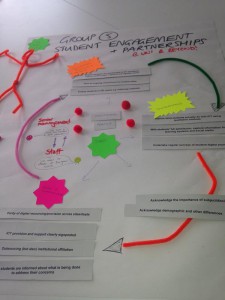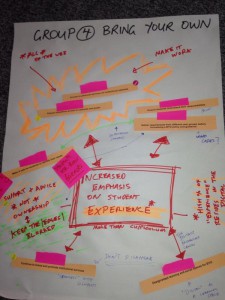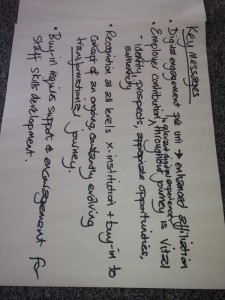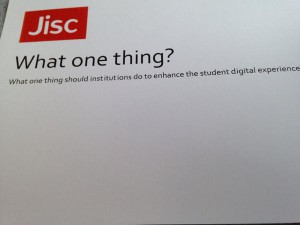We always planned for this final event to be something of an editorial meeting, with people who have joined us along the journey helping to shape our final messages for the sector. In fact it was more of a design meeting, as the twitter stream and photographic evidence both show.
Pipecleaners, bobbles, directional arrows and hand-drawn cartoons all helped to create the ‘atelier’ environment we were looking for, though there was a set of draft findings available on googledocs – ‘institutional solutions’ – to keep us focused on what institutions really need to hear.
In the morning we split into five groups to consider each of the five key sets of institutional solutions. These were:
1a. Prepare and support students to study effectively with digital technologies
1b. Support digital identity/affiliation across the student journey
2a. Provide a robust, flexible digital infrastructure
2b. Develop digitally rich spaces and places of learning
3a. Support and develop teaching staff skills
3b. Embed appropriate digital experiences into the curriculum
4. Support students to bring their own devices/services/information
5. Engage students in dialogue and partnership around their digital experience
The final messages from the five groups are available here:
In the afternoon we explored how Jisc and its co-funding partners could best support institutions in achieving the solutions we had identified. A number of ideas were presented from earlier phases of the consultation, and there was an opportunity to offer new ideas as well. Small groups then worked up their chosen ideas into posters, and the whole group ‘voted’ for the solutions they felt would have the most impact on the student experience and, separately, for the solutions they felt their institution would actively sign up for and support.
‘A strategic approach‘ was by far the most popular idea, with ten votes of confidence but only one institution offering practical support to make it happen. This solution focused on tools for engaging, persuading and empowering senior managers to enhance the student digital experience. Jisc would use its high profile and influence with partners to guide institutions along a development pathway, offering resources and support along the way. This might include direct consultancy, speakers for events, a toolkit for benchmarking, self-evaluation and awareness raising; a range of exemplars; a ‘CAMEL’ type community for sharing strategic ideas and practices.
J-Ex – ‘creating the space for institutions to have the conversations they need to have’ – received four positive votes and five commitments in practice, making it the second most popular idea. It had similarities with several other solutions (including the first): Jisc was seen as a national facilitator, ‘scene setter’ and legitimiser of innovative practice, in this case both through a ‘toolkit/model’ but more importantly through national ‘conversations’ and exchanges of ideas. A similar idea was ‘Sharing joined-up learning practices’ (one vote for impact, one offer). Again Jisc was seen as having the authority to ‘speak on topics reflecting the community as a whole‘ and to build national partnerships for change.
Research clearing garnered three votes for impact and four practical offers, mainly from institutions that would be keen to share data. This solution offered both general briefings/guidance and specific tailored services to institutions based on analysis of a range of research data, including survey findings provided by institutions themselves. A similar idea (one vote for impact, one for support), ‘Cross-sector knowledge sharing platform’ set out how an interface on this kind of data/knowledge might look to users. In this model Jisc were described as ‘knowledge sharing evangelists – people who seek out and articulate best practice to share‘.
It is interesting to note the similarities among these different solutions. All emphasise the role that Jisc can play in leading, legitimising and facilitating change of practice. Common solutions include: benchmarking and supporting institutional audit/maturity/readiness assessment; clearing, collating and managing relevant data on student experiences and expectations; providing speakers, consultants and other forms of expertise; hosting conversations; sharing ideas about practice including via case studies, exemplars and evidence; providing models and frameworks, especially strategic frameworks; building national partnerships.
Finally, participants wrote postcards to their home institutions expressing ‘what one thing?’ should be done to enhance students’ digital experiences. Read the ‘what one thing?’ results here, add your own ideas below, and be ready to comment on our final recommendations – coming soon.







2 replies on “Final consultation event and ideas for the future”
[…] National solutions – blog post summarising outcomes from the final consultation event […]
[…] that we’ve completed our consultation with HE stakeholders, it’s time to ask what you are doing to enhance the student digital experience. There are no […]